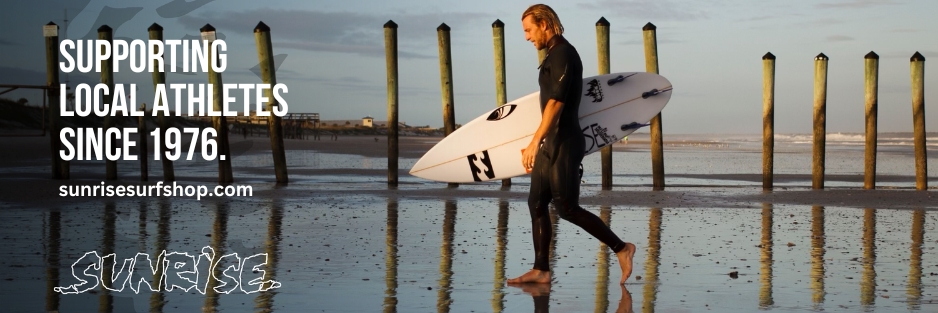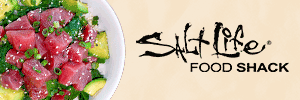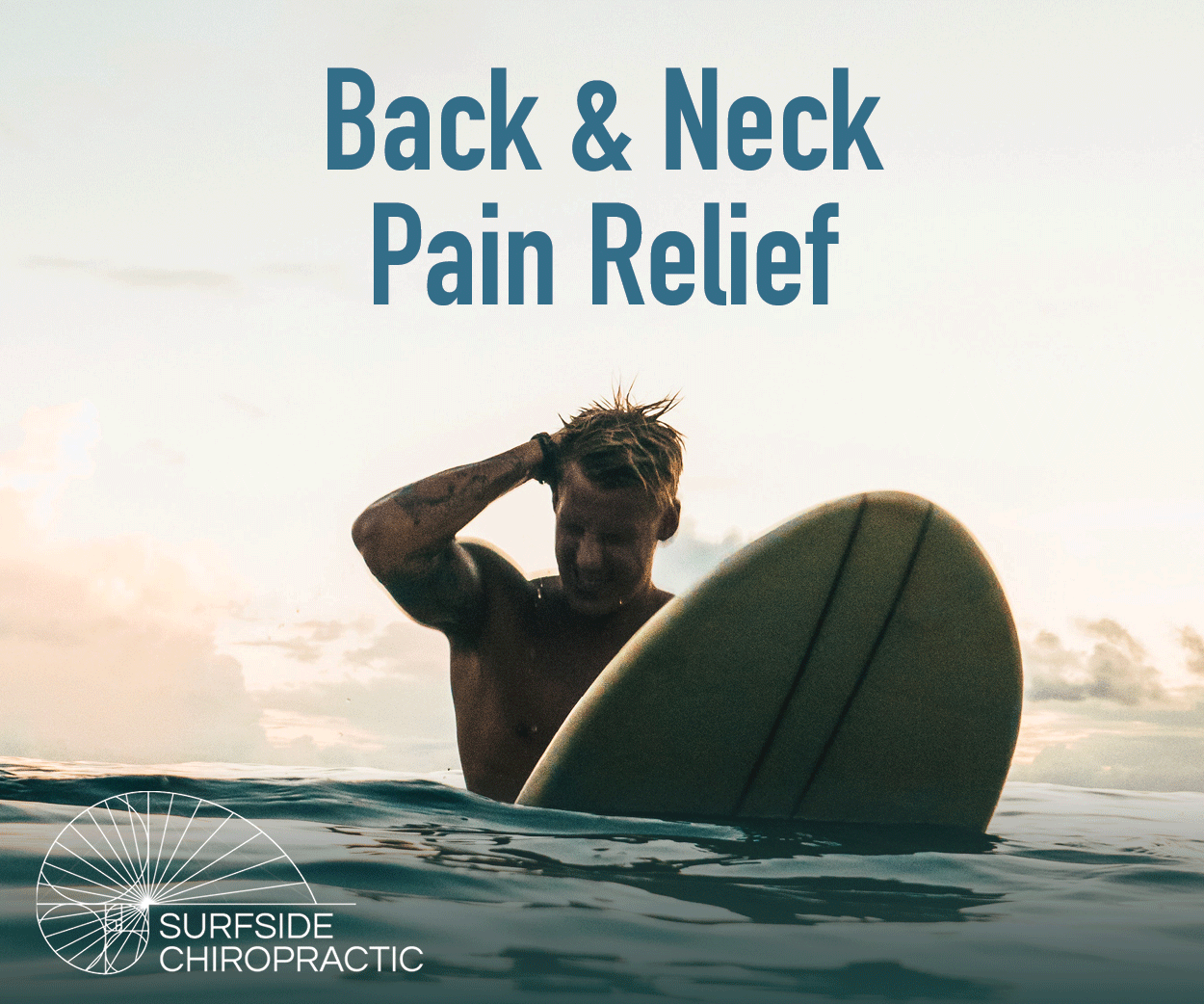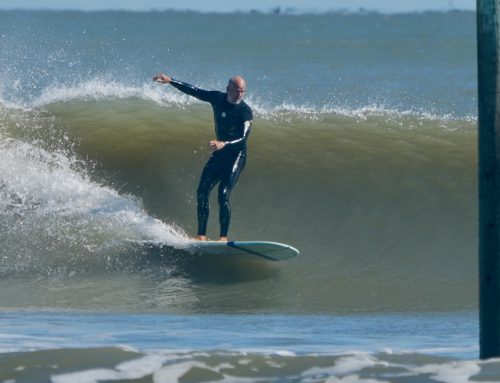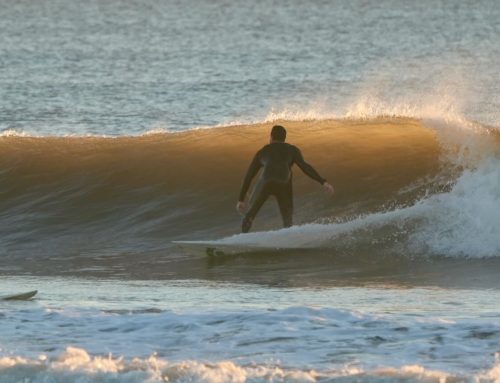The Edge – Volume 65
By Glenn T Goodwin, PhD
If you surf everyday, this may not be what you need. If not, then read on…
It probably goes without saying, that the pop-up may be one of the most crucial elements in surfing a wave. If your pop-up is at just the right time, with optimum foot-placement and centered body stance, then you are poised for whatever you have in mind. On the other hand, a bad pop-up with awkward foot placement, can often be hard to recover from. The process of the pop-up is multifactorial and dependent on strength, agility, mind-body quickness, dynamic balance and intuitive wave knowledge. Obviously, certain wave conditions are more critical than others, but even when its small, soft and mushy, getting it right on your pop-up, sets everything else into fluid motion.
 In my opinion, the older you get and/or the less often you surf, the more important it is to work on your pop-up in between sessions, especially if you ride shortboards. I actually keep an old shortboard in the house without fins, lay it down on the floor and roll up a yoga pad, placing it under the tail area to lift up the tail 5 or 6 inches to simulate the board position and angle on a take-off and drop-in. Then I get in the paddling position on my board, take a few strokes and pop-up, always trying to get my feet planted exactly where I want them; and that’s how I stay I touch with my pop-ups when its flat.
In my opinion, the older you get and/or the less often you surf, the more important it is to work on your pop-up in between sessions, especially if you ride shortboards. I actually keep an old shortboard in the house without fins, lay it down on the floor and roll up a yoga pad, placing it under the tail area to lift up the tail 5 or 6 inches to simulate the board position and angle on a take-off and drop-in. Then I get in the paddling position on my board, take a few strokes and pop-up, always trying to get my feet planted exactly where I want them; and that’s how I stay I touch with my pop-ups when its flat. 
I came across this pop-up exercise review by Michelle Drielsma, who describes herself as a frother, mover, and passionate about long-term surf performance. From a neurophysiological standpoint its about mind-body synchronicity, so this all makes sense to me. The embers are glowing in the tropics, so check it out and then get your own little routine going to work on pop-ups. See if it makes a difference in the water.
Michelle says, ‘the pop up is one of the most basic movements in surfing while also causing some of the greatest challenges for beginning surfers. Optimizing your hip mobility, pushing strength, and hip-flexion-trunk-flexion are all necessary components of bringing your feet under your hips smoothly. If you have the base requirements of being able to do a pain-free deep squat, a push-up, and are able to pike your hips up while bringing your feet forward in one fluid motion, surfing itself will be your best teacher. Many beginner surfers however, do not have these base requirements and would benefit from these strength and conditioning techniques.
The sequence to improving your pop up involves:
Mobility & Joint Health
Check whether you have the adequate hip internal and external rotation, hip flexion, and ankle flexion. Trying to force large degrees of joint motion where there is no joint motion to start with sets up the potential for unhappy, inflamed, sore joints. Your hips, knees and ankles want to be happy for a lifetime of surfing.
Strength Foundations
Can you do several push-ups without neck or belly sag occurring? Can you push up with your elbows tucked in and close to your chest? Narrow width push up strength is huge for winning at pop ups.
Hip-flexion-trunk-flexion integration, strength, and speed. We need to develop the ability to bring push with our arms and pike our hips up with control, by using our trunk flexors and hip flexors. A great way to achieve this is with our chest facing down, similar to an actual pop up, with our feet on a swiss ball. Jacknife and Pike exercises will strengthen trunk flexion and hip flexion whilst needing to maintain shoulder stability, similar to actual pop-ups.
Practice the Skill
Practice the pop-up movement on land, practice the movement on a soft-board or long-board and then finally practice on a shorter board. Avoid the temptation to use your feet on land as you will not be able to use them when your feet are hanging off the back of the board.
*The video below demonstrates 5 of Michelle’s top mobility/strength exercises in helping optimize the pop up.
Hip Mobility
A) This active Quad and Hip Flexors mobility exercise is one of many techniques that can improve your ability to use the muscles at the front of your hips, allowing you to get into a deep squat position. Cushion your knee and position your shin up against a wall or block, squeeze your abs and glutes to flatten your lower back, and raise your torso. Lift your same-side arm across the midline of your body to intensify the stretch on the hip flexors.Make sure you keep your lower back as flat as possible. The active part of this is now to push your foot against the wall or block as hard as you safely can (using your quads) for 10 seconds and then intend to lift your foot off the wall as hard as you safely can (using your hamstrings) for 10 seconds. Complete three reps and then switch sides.
B). Hip Internal and External Rotation Weighted Sit Ups
This movement will help to improve your hip internal rotation mobility of your leg positioned behind your torso and also hip external rotation mobility (although less aggressively) of your leg positioned in front of your torso. Start with bodyweight only and progress to holding a 2-6kg weight when you feel ready. For some people it can be a challenge just to get into this hip position. Lean your torso over your back leg (to challenge hip internal rotation). Take your bodyweight through your legs, extend your hips up off the floor and rotate your torso toward your front leg. If you can hold a weight such as a medicine ball, lean over your back leg and then hold the ball far from your torso as your sit up and slowly lower to the ground.
Push Up
It is paramount that you can do a really good push up, keeping your torso still, your neck in line with your spine and your lower back flat. Push-ups with your elbows tucked in and close to your chest, not with elbows flaring out to the sides, is more surf specific. You can try different variations, such as single arm planks to challenge shoulder and core stability. Try to keep your hips from rotating upward (with single arm planks) as you rotate your upper body to target your core strength. BOSU push-ups can be a good training alternative and elevating your feet will make this more challenging.
Swiss Ball Jacknife
This exercise is great for integrating your hip flexion-core integration for core strength and core control.. The jacknife mimics the strength and control requirements for a pop up pretty well. You can do this with your spine completely neutral (to challenge your ability to stabilize your spine when forces are acting upon it) or you can round your lower back with control (which is what I am doing in the video), although I tend to round even further and bring my knees to touch my mid triceps. I would start with spine neutral and then progress to rounding your spine as the surf pop up requires you to round your back.
Swiss Ball Pike
The pike is the jacknife on steroids. This increases the strength and control required for hip flexion and trunk flexion. The shoulders have to take more load and the mobility requirements are also intensified as you are required to basically balance almost your entire bodyweight over your hands and shoulders.
Pop Ups on Land
These aren’t going to be as good as actually practicing pop ups in the surf but they are a good way to start developing the mechanics you need in the surf. Figure out how to stand up without pushing off with your feet, as you won’t be able to use your feet in the water when your toes are hanging off the back of the board. You don’t need to practice both sides if it confusing your development of skill to one side.’
For a super comprehensive surf strength and conditioning training program that you can follow from anywhere in the world, with or without any training equipment, head to surfstrengthconditioning.com

